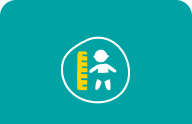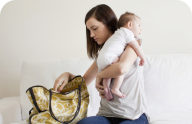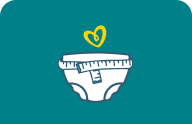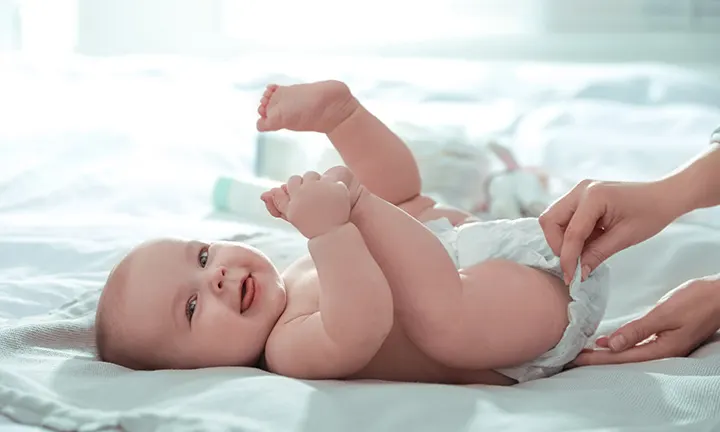How to Prevent and Handle Diaper Blowouts
Experienced messy diaper blowouts? Whether it’s a diaper leaking from behind or your baby peeing through the diaper, the right fit and absorbency can make all the difference. Here’s how to keep leaks under control:
Quick Fixes for Diaper Blowouts:
Check the fit. A snug diaper prevents leaks. If you’re unsure how a diaper should fit, our Pampers diaper size chart can help.
Size up when needed. Do blowouts mean the diaper is too small? Sometimes! If leaks are frequent, it may be time to size up diapers.
Choose the right diaper. The best diapers for blowouts have strong absorbency. Pampers Swaddlers and Cruisers 360° feature a Blowout Barrier for added protection.
Change diapers regularly. A newborn peeing through a diaper often happens when it’s too full. Frequent changes prevent overflows.
Check for tucked cuffs. A diaper leaking from behind is often caused by leg cuffs being tucked in—make sure they’re pulled out.
With the right diaper and fit, you can prevent diaper blowouts and make cleanups easier. Keep reading to learn why they happen and how to prevent blowouts.
What are Diaper Blowouts and Why Do They Happen?
A diaper blowout happens when a diaper fails to contain poop or pee, leading to leaks up the back, out the leg openings, or from the waistband. These messy incidents are common. While frustrating, diaper blowouts can often be minimized with the right diaper size, fit, and timely changes.
Several factors can lead to diaper leaks and blowouts:
Diaper size and fit. If a diaper is too small, it may not have enough absorbent material, increasing the risk of a diaper leaking from behind or through the leg openings. On the other hand, if a diaper is too big, gaps around the waist or legs may allow leaks before the material can absorb moisture.
Absorption and frequency of changes. If a diaper reaches its absorbency limit, it can result in the baby peeing through the diaper.
Dietary factors. Breastfed babies tend to have looser stools, which may contribute to diaper blowouts. As babies transition to solids, their digestion changes, which may affect poop consistency and how well a diaper contains it.
If your newborn keeps peeing through their diaper or frequently experiences leaks, it may be time to size up diapers.
How to Handle Diaper Blowouts
No parent enjoys dealing with a diaper blowout, but when it happens, staying calm and prepared can make cleanups easier. So, what should you do if your baby has a blowout?
Follow these steps to handle the mess efficiently:
Diaper blowouts can be messy, but with the right approach, you can clean up quickly and reduce the chances of future mishaps. In the next section, we’ll explore how to prevent diaper blowouts so you can avoid dealing with them as often.
Preventing Diaper Blowouts
A diaper blowout can be a messy surprise, often caused by the wrong size or an improper fit. Do blowouts mean the diaper is too small? In many cases, yes. If your baby’s diaper frequently leaks, feels too tight, or leaves red marks on the waist or thighs, it may be time to size up diapers.
To help prevent diaper leaks, Pampers Swaddlers and Cruisers 360° now feature a Blowout Barrier, designed to close gaps at the back and waist for up to 100% leak protection. Combined with Dual Leak Guard barriers at the legs, this extra layer helps keep messes contained while providing a snug and comfortable fit.
A well-fitting diaper should cover your little one’s bottom completely, sit securely around the waist, and have stretchy leg cuffs to prevent the diaper leaking from behind. Choosing the best diaper for blowouts can make diaper changes easier and minimize accidents, whether you're at home or on the go.
Choosing the Right Diaper Size
Size is a huge part of finding your little one's correct diaper fit. As you know, babies come in all different shapes and sizes. And just like clothing, diapers fit every baby differently.
Pampers diaper sizes are organized by weight, and since no two babies are the same shape, you will notice some overlap between sizes. In most cases, your little one should be within the weight range for the size you are using. Check out the weight range for each size of Pampers Swaddlers, Cruisers 360, and Baby Dry.
Ensure the Diaper Fits Well
A well-fitting diaper helps prevent diaper leaks and keeps your baby comfortable. When you change your baby's diaper you should also check for:
Snug waistbands. The diaper should sit just below the belly button.
Leg cuffs. Make sure they wrap neatly around the legs and are pulled out, as tucked-in cuffs can cause diaper leaking from behind.
Secure Fastening. Tapes should be symmetrically placed on the waistband. Pampers diapers stretch for a custom fit. Make sure they are not fastened too tightly or too loosely.
If your little one is still a newborn, you’ll need to be extra careful around the umbilical cord area until it heals completely. Check out this article about umbilical cord care for more on caring for your baby’s delicate skin as you change their diaper.
Changing your Baby’s Diet
Occasional diaper blowouts and leaks are normal and not always linked to their diet. However, a baby’s stools may change depending on what they eat and their stage of development.
Breastfed babies typically have softer stools than formula-fed babies, which may make blowouts more likely. Switching from breast milk to formula, or changing formulas, can also affect stool consistency. If your baby is around 6 months old and starting solids, their digestion will naturally shift as they adjust to new foods.
Since every baby is different, frequent diaper blowouts or noticeable changes in poop color may warrant a check-in with your baby’s healthcare provider to rule out any concern
The Bottom Line
Diaper blowouts are a common part of babyhood, but choosing the right diaper size, ensuring a snug fit, and making frequent changes can help prevent leaks. If blowouts happen often, checking the Pampers diaper size chart can help you determine if it’s time to size up diapers.
While stocking up on diapers and wipes, don’t forget to earn rewards! Download the Pampers Rewards App to turn your purchases into exclusive savings on baby essentials.
How We Wrote This Article The information in this article is based on expert advice found in trusted medical and government sources, such as the American Academy of Pediatrics and the American College of Obstetricians and Gynecologists. You can find a full list of sources used for this article below. The content on this page should not replace professional medical advice. Always consult medical professionals for full diagnosis and treatment.
Join a World of Support
through Pregnancy and Parenthood.
TRACK WITH TOOLS
LEARN WITH EXPERTS
GET REWARDED













